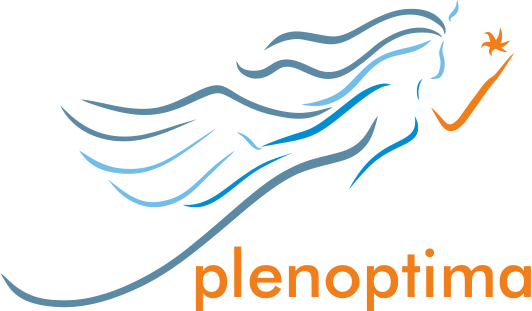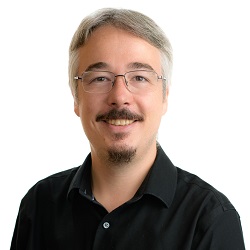 Donald Dansereau is a continuing academic at the Sydney Institute for Robotics and Intelligent Systems at the University of Sydney. His work explores how new imaging devices can help robots see and do, encompassing the design, fabrication, and deployment of new imaging technologies. In 2004 he completed an MSc at the University Calgary, receiving the Governor General’s Gold Medal for his pioneering work in light field processing. In 2014 he completed a PhD on underwater robotic vision at the Australian Centre for Field Robotics, followed by postdoctoral appointments at the Queensland University of Technology and Stanford University. Dr Dansereau authored the Light Field Toolbox for Matlab, and his ongoing research includes the application of light fields to challenging tasks in machine perception.
Donald Dansereau is a continuing academic at the Sydney Institute for Robotics and Intelligent Systems at the University of Sydney. His work explores how new imaging devices can help robots see and do, encompassing the design, fabrication, and deployment of new imaging technologies. In 2004 he completed an MSc at the University Calgary, receiving the Governor General’s Gold Medal for his pioneering work in light field processing. In 2014 he completed a PhD on underwater robotic vision at the Australian Centre for Field Robotics, followed by postdoctoral appointments at the Queensland University of Technology and Stanford University. Dr Dansereau authored the Light Field Toolbox for Matlab, and his ongoing research includes the application of light fields to challenging tasks in machine perception.
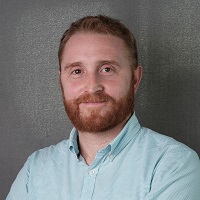 Giacomo Boracchi is an Associate Professor of Computer Engineering at Dipartimento di Elettronica, Informazione e Bioingegneria of the Politecnico di Milano, where he also received the Ph.D. in information technology (2008), after graduating in Mathematics (Università Statale di Milano, 2004). His research interests concern image processing and machine learning, and in particular image restoration and analysis, change/anomaly detection, domain adaptation. Since 2015 he is leading industrial research projects concerning machine learning models for analyzing optical signals, algorithms for X-ray inspection systems, automatic quality inspection systems for monitoring silicon wafer production, and anomaly detection in web-sessions. He is currently associate editor for IEEE Transactions on Image Processing and served as AE for IEEE Computational Intelligence Magazine. In 2015 he received the IBM Faculty Award, in 2016 the IEEE Transactions on Neural Networks and Learning Systems Outstanding Paper Award, in 2017 the Nokia Visiting Professor Scholarship. He has also received multiple hardware grants from nVidia. He has held tutorials in major IEEE conferences: ICIP 2020, ICASSP 2018 and IJCNN 2017, 2018.
Giacomo Boracchi is an Associate Professor of Computer Engineering at Dipartimento di Elettronica, Informazione e Bioingegneria of the Politecnico di Milano, where he also received the Ph.D. in information technology (2008), after graduating in Mathematics (Università Statale di Milano, 2004). His research interests concern image processing and machine learning, and in particular image restoration and analysis, change/anomaly detection, domain adaptation. Since 2015 he is leading industrial research projects concerning machine learning models for analyzing optical signals, algorithms for X-ray inspection systems, automatic quality inspection systems for monitoring silicon wafer production, and anomaly detection in web-sessions. He is currently associate editor for IEEE Transactions on Image Processing and served as AE for IEEE Computational Intelligence Magazine. In 2015 he received the IBM Faculty Award, in 2016 the IEEE Transactions on Neural Networks and Learning Systems Outstanding Paper Award, in 2017 the Nokia Visiting Professor Scholarship. He has also received multiple hardware grants from nVidia. He has held tutorials in major IEEE conferences: ICIP 2020, ICASSP 2018 and IJCNN 2017, 2018.
 Alessandro Foi received the M.Sc. degree in Mathematics from the Università degli Studi di Milano, Italy, in 2001, the Ph.D. degree in Mathematics from the Politecnico di Milano in 2005, and the D.Sc.Tech. degree in Signal Processing from Tampere University of Technology, Finland, in 2007. He is Professor of Signal Processing at Tampere University, Finland.
Alessandro Foi received the M.Sc. degree in Mathematics from the Università degli Studi di Milano, Italy, in 2001, the Ph.D. degree in Mathematics from the Politecnico di Milano in 2005, and the D.Sc.Tech. degree in Signal Processing from Tampere University of Technology, Finland, in 2007. He is Professor of Signal Processing at Tampere University, Finland.
His research interests include mathematical and statistical methods for signal processing, functional and harmonic analysis, and computational modeling of the human visual system. His work focuses on spatially adaptive (anisotropic, nonlocal) algorithms for the restoration and enhancement of digital images, on noise modeling for imaging devices, and on the optimal design of statistical transformations for the stabilization, normalization, and analysis of random data.
He is the Editor-in-Chief of the IEEE Transactions on Image Processing. He previously served as a Senior Area Editor for the IEEE Transactions on Computational Imaging and as an Associate Editor for the IEEE Transactions on Image Processing, the SIAM Journal on Imaging Sciences, and the IEEE Transactions on Computational Imaging. He is a Fellow of the IEEE.
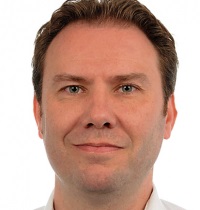 Sebastian Knorr is professor at the Ernst Abbe University of Applied Sciences Jena and Associate Editor for the IEEE Trans. on Multimedia. Between 2017 and 2020, he was Senior Research Scientist and Lecturer within the Communication Systems Group at TU Berlin and Senior Research Scientist within the V-SENSE project at Trinity College Dublin. Between 2009 and 2016, he was the Managing Director of imcube labs GmbH, Germany and General Manager of Beijing imcube Technologies Co., Ltd.. Besides the management of both companies, he also worked on 3D TV, cinema and giant screen projects as Post-Conversion Stereographer and Stereo Producer. Between 2002 and 2009, Dr. Knorr acted as project manager and senior researcher in the Communication Systems Lab at Technische Universität Berlin, Germany. In 2007 he invented the process of automatic 2D to 3D image conversion with highly advanced computer vision technology and received the Dr.-Ing. degree (Ph.D.) with highest honors in 2008.
Sebastian Knorr is professor at the Ernst Abbe University of Applied Sciences Jena and Associate Editor for the IEEE Trans. on Multimedia. Between 2017 and 2020, he was Senior Research Scientist and Lecturer within the Communication Systems Group at TU Berlin and Senior Research Scientist within the V-SENSE project at Trinity College Dublin. Between 2009 and 2016, he was the Managing Director of imcube labs GmbH, Germany and General Manager of Beijing imcube Technologies Co., Ltd.. Besides the management of both companies, he also worked on 3D TV, cinema and giant screen projects as Post-Conversion Stereographer and Stereo Producer. Between 2002 and 2009, Dr. Knorr acted as project manager and senior researcher in the Communication Systems Lab at Technische Universität Berlin, Germany. In 2007 he invented the process of automatic 2D to 3D image conversion with highly advanced computer vision technology and received the Dr.-Ing. degree (Ph.D.) with highest honors in 2008.
Dr. Knorr is a Senior Member of the Institute of Electrical and Electronics Engineers (IEEE) and the German Society of Television- and Cinema Technology (FKTG e.V.). He also serves as board member of the IDloop GmbH. Dr. Knorr received the German Multimedia Business Award of the Federal Ministry of Economics and Technology in 2008, and was awarded by the initiative “Germany-Land of Ideas” which is sponsored by the German government, commerce and industry in 2009, respectively. In 2012, he received the Scott Helt Memorial Award for the best paper published in the IEEE Transactions on Broadcasting in 2011. In 2018, Dr. Knorr received the Lumiére Award for the best paper published at the International Conference on 3D Immersion.
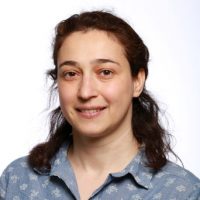 Humeyra Caglayan is an associate professor of physics in the Faculty of Engineering and Natural Sciences at Tampere University and leads the Metaplasmonics group. She received her Ph.D. degree in Physics from Bilkent University, Turkey, in 2010, where she investigated the novel electromagnetic phenomena in metamaterials and plasmonic structures. After her PhD studies, she worked as a postdoctoral scholar in Prof. Nader Engheta’s group at the University of Pennsylvania. Her group (Metaplasmonics) focuses on engineering the fundamental interaction between light and matter at the nanometer scale for plasmonic and metamaterial-based devices. She is an H2020 ERC Starting Grant holder (2019-2023).
Humeyra Caglayan is an associate professor of physics in the Faculty of Engineering and Natural Sciences at Tampere University and leads the Metaplasmonics group. She received her Ph.D. degree in Physics from Bilkent University, Turkey, in 2010, where she investigated the novel electromagnetic phenomena in metamaterials and plasmonic structures. After her PhD studies, she worked as a postdoctoral scholar in Prof. Nader Engheta’s group at the University of Pennsylvania. Her group (Metaplasmonics) focuses on engineering the fundamental interaction between light and matter at the nanometer scale for plasmonic and metamaterial-based devices. She is an H2020 ERC Starting Grant holder (2019-2023).
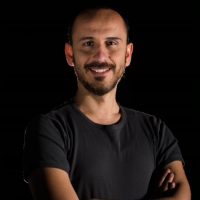 Erdem Sahin received the Ph.D. degree from the Electrical and Electronics Engineering Department, Bilkent University in 2013. In 2014, he joined the 3D Media Group in the Faculty of Information Technology and Communication Sciences at Tampere University, as Marie Curie Experienced Researcher, where he has been Senior Research Fellow since 2019. Currently, he is leading the Computational Displays and Cameras Team within the 3D Media Group, and he is the principal investigator of the Plenoptics Lab at the Centre for Immersive Visual Technologies. Erdem has co-initiated several national and international research projects on plenoptic imaging. His current research interests include development of computational light field and holographic imaging algorithms and methods for next-generation plenoptic cameras and displays.
Erdem Sahin received the Ph.D. degree from the Electrical and Electronics Engineering Department, Bilkent University in 2013. In 2014, he joined the 3D Media Group in the Faculty of Information Technology and Communication Sciences at Tampere University, as Marie Curie Experienced Researcher, where he has been Senior Research Fellow since 2019. Currently, he is leading the Computational Displays and Cameras Team within the 3D Media Group, and he is the principal investigator of the Plenoptics Lab at the Centre for Immersive Visual Technologies. Erdem has co-initiated several national and international research projects on plenoptic imaging. His current research interests include development of computational light field and holographic imaging algorithms and methods for next-generation plenoptic cameras and displays.
